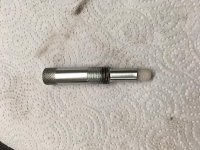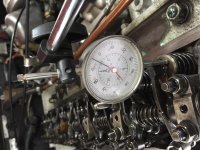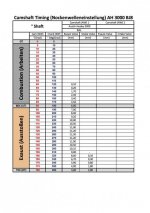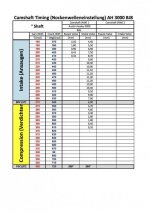Lutz, You're welcome. This is a perplexing problem. I would bet it's probably a stock cam, and hope that if it is a performance cam, its specifications, or part number would have been noted on the invoice.
To answer your question: High performance camshafts can have higher valve lift, duration, and valve opening overlap. Generally, when one installs a camshaft of this type, a procedure known over here as "degreeing the camshaft" needs to be followed to ensure that the cam is timed properly. Sometimes an adjustable cam gear, or an offset keyway will need to be installed with the cam gear, to properly adjust the cam timing. If the valves are not opening at the right time - I mean a few degrees error, not a lot, the engine will probably run, and the ignition timing MIGHT have to be set to occur earlier (or later), and the engine might seem to run OK with those settings.
If you can measure when the maximum lift of the valves in cylinder #1 occurs, you could compare that result with the stock cam specifications in the repair manual (or Google!). That could at least tell you if the cam timing is close to where it is supposed to be, and then cross that off of your list! The measurements that I described in the previous post shouldn't be too difficult or disruptive. You will have to remove the valve cover, and then mark and measure those points on the damper/pulley, but no major disassembly is needed.
See:
https://www.iskycams.com/cam-degreeing.html This is a good explanation of theory, and what's going on, but don't get too caught up in all of the detailed procedures - the site describes what to do during an initial engine build. I am just suggesting a simple way of finding out when the valves are completely open, and comparing that data to the specs.
Cam timing is not only important for correct engine operation, but it is especially important if an engine has overhead cams, a hemispherical combustion chamber, or domed, high-compression pistons. With these situations, there is a real possibility, with even a small timing error, of a valve contacting a piston and jamming - or worse. Fortunately these old Austin engines are fairly low-tech, have flat-topped pistons, and relatively low compression, so unless the cam timing is way out, there isn't much danger of a valve/piston contact.
If your car was running OK, I don't think there is anything to panic about, but this is a mystery, and should be solved! I hope you can figure out what's going on, and that I haven't overthought this, and made the issue any more difficult, or confusing! Jim

 Hey there Guest!
Hey there Guest!
 smilie in place of the real @
smilie in place of the real @
 Pretty Please - add it to our Events forum(s) and add to the calendar! >>
Pretty Please - add it to our Events forum(s) and add to the calendar! >> 





 A friendly reminder - be careful what links you click on here. If a link is posted by someone you don't know, or the URL looks fishy, DON'T CLICK. Spammers sometimes post links that lead to sites that can infect your computer, so be mindful what you click.
A friendly reminder - be careful what links you click on here. If a link is posted by someone you don't know, or the URL looks fishy, DON'T CLICK. Spammers sometimes post links that lead to sites that can infect your computer, so be mindful what you click.